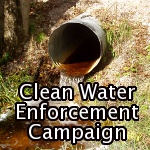The California Sportfishing Protection Alliance (CSPA) and Friends of the River (FOR) led a coalition of environmental groups and the Winnemem Wintu Tribe in a protest of the water right application for the proposed Sites Reservoir. CSPA filed the protest with the State Water Resources Control Board on August 31, 2023.
In addition to CSPA, FOR, and the Winnemem Wintu Tribe, joining the protest were AquAlliance, California Water Impact Network, CalWild, Fly Fishers of Davis, Friends of the Swainson’s Hawk, Northern California Council of Fly Fishers International, Restore the Delta, Save California Salmon, Sierra Club California, and Water Climate Trust.
If constructed, Sites Reservoir would have a capacity of 1.5 million acre-feet, making it the largest reservoir constructed in California since the 1970s. It would divert water from the Sacramento River to what is presently a large valley west of the river in Colusa County.
CSPA’s Executive Director Chris Shutes described the Sites Project in a press release as follows:
Building new reservoirs will never solve the problem of giving away too much water. Sites would join a system of reservoirs whose drains are too big for their spigots. The supposed environmental benefits rely on promises of responsible management by the people who give away too much water in the first place. The pay-to-play model is inequitable and unjust. Sites Reservoir is a bad deal for California: for its fish and wildlife, for its rivers, for its people.
The introduction to the protest is reproduced below.
The Sites Reservoir project is founded on the dual deception that a massive new diversion from the Bay-Delta watershed will improve water supply reliability and improve environmental protection. It is doubly wrong.
Fish and rivers throughout the Central Valley are hemorrhaging. The state and federal water projects,[1] their agencies,[2] and their contractors have led these fish to the brink of extinction and these rivers to degradation and loss of basic function. Now, changing their hats to appear as partisans of local solutions in the Sacramento Valley, these agencies and their contractors ask for more water and more public money, and propose to control 90% of the water in a shiny new project, but with no new responsibilities to protect the public resources they have so masterfully decimated.
The Sites project lives in the faded dream of the mid-twentieth century, whose central tenet was that when water supply is short, the solution is to pour more concrete and divert more water. It is no wonder that the Sites water rights application claims it is true to, and seeks to implement, a project that was first put on the books in 1977. That 1977 “state filed application” for water, in turn, is grounded in a view of water development that was passed into law in 1927.
The Sites project is deeply inequitable. It harms all those who rely on rivers and fish for their livelihoods and sustenance, as well as for their enjoyment. This includes tribal communities whose connection to rivers, fish, and associated environments, are, in addition, cultural and religious. The Sites project will create some of the most expensive water in the state, affordable to only a few. It will thus tend to push costs for water higher generally, making water less accessible to disadvantaged communities.
Water is the lifeblood of California’s rivers and fisheries. The Sites project is consistent with, and founded on, a coordinated plan for the state’s water that systemically bleeds rivers, fisheries, and communities dry. There will be no water supply reliability in the Central Valley until demand for water is brought into line with what Central Valley hydrology can reliably provide. There will be no humane recognition of tribal sovereignty or the public trust until this paradigm shifts.
The proponents of Sites Reservoir won’t produce a plan for operating their 1.5 million acre-foot reservoir until after it is approved. But they ask the people of California to trust them. They tell us it will give them the resources to protect fish this time around. Throughout California’s history, reservoir backers have promised the world every time a new dam is built, and they have always failed to deliver. The overall result of the 1400 dams in California has been salmon and other fish species declining towards extinction, the loss of over 90% of California’s wetlands, degraded water quality, and expanding toxic algae blooms in the Bay and Delta. Sites would not be the first dam to over-promise and under-deliver.
Past practice is the best indicator of future behavior. The state and federal projects, and their regulators at the State Water Board and the fish agencies, have the ability, the authority, and indeed the obligation to manage limited water resources to protect fish and rivers today. They have done the opposite. They systematically give away too much water. During dry year sequences, the projects routinely come crying to the regulators for “temporary” changes to already inadequate fisheries protections, and the regulators routinely oblige, without requiring accountability for how the latest predictable “emergency” came about.
The Sites project promises so many benefits, but what solid benefits are there really? Water for wildlife refuges that the state and federal projects should already be delivering to make up for the destruction of enormous amounts of Central Valley habitat. A pittance of water for Delta smelt in an experimental project whose effectiveness is based on a prayer.
And then there is process. So much process. The proponents of Sites, to the degree they are not already participants in the management committees that have run fish into the grave, will join the resource agencies and the water users already in the room, and talk, talk, talk.
The history of the state and federal water projects and their contractors is that they fight like crazy to make constraints on water deliveries as weak as possible. Once established, the state and federal projects and their contractors painstakingly game those constraints to maximize long-term water deliveries. The idea that voluntary consultation without strong regulation is enough to restore the state’s public trust fishery and river resources utterly ignores the dismal outcome of past consultation with inadequate rules and enforcement.
The Sites Application supports itself with talking points on how the state will run out of water under conditions of climate change. It is a new tambourine banging out the same old tune. This protest is founded on the principle that if the State of California does not set limits on water use, and instead allows the state and federal projects to keep taking, taking, taking, the state is going to run out of fish and living rivers.
[1] State Water Project (SWP) and Central Valley Project (CVP).
[2] California Department of Water Resources (DWR) and Bureau of Reclamation (Reclamation).









